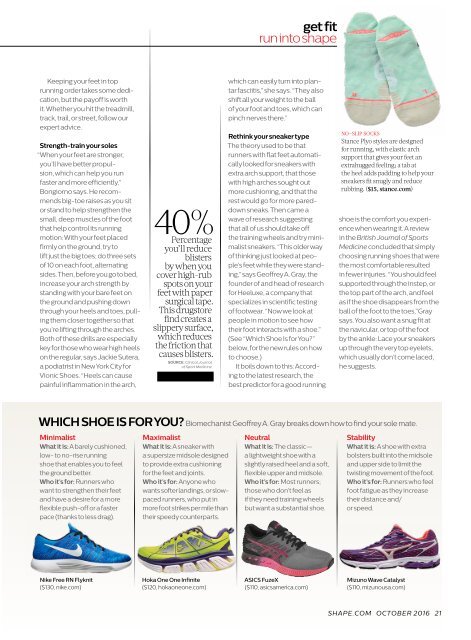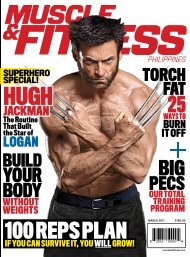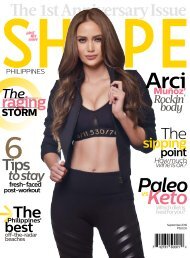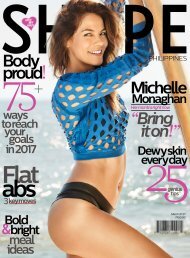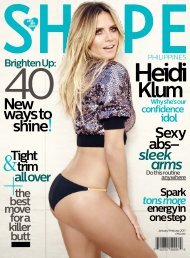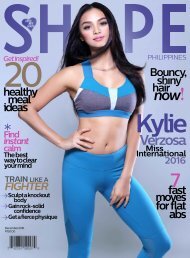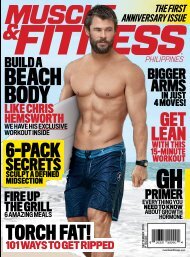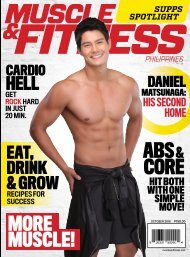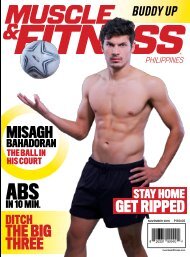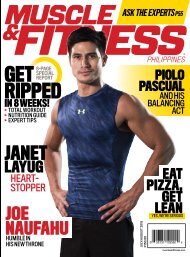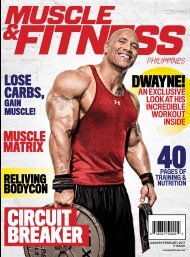SHAPE_OCTOBER_2016
You also want an ePaper? Increase the reach of your titles
YUMPU automatically turns print PDFs into web optimized ePapers that Google loves.
un into shape<br />
Keeping your feet in top<br />
running order takes some dedication,<br />
but the payoff is worth<br />
it. Whether you hit the treadmill,<br />
track, trail, or street, follow our<br />
expert advice.<br />
Strength-train your soles<br />
“When your feet are stronger,<br />
you’ll have better propulsion,<br />
which can help you run<br />
faster and more efficiently,”<br />
Bongiorno says. He recommends<br />
big-toe raises as you sit<br />
or stand to help strengthen the<br />
small, deep muscles of the foot<br />
that help control its running<br />
motion: With your feet placed<br />
firmly on the ground, try to<br />
lift just the big toes; do three sets<br />
of 10 on each foot, alternating<br />
sides. Then, before you go to bed,<br />
increase your arch strength by<br />
standing with your bare feet on<br />
the ground and pushing down<br />
through your heels and toes, pulling<br />
them closer together so that<br />
you’re lifting through the arches.<br />
Both of these drills are especially<br />
key for those who wear high heels<br />
on the regular, says Jackie Sutera,<br />
a podiatrist in New York City for<br />
Vionic Shoes. “Heels can cause<br />
painful inflammation in the arch,<br />
40%<br />
Percentage<br />
you’ll reduce<br />
blisters<br />
by when you<br />
cover high-rub<br />
spots on your<br />
feet with paper<br />
surgical tape.<br />
This drugstore<br />
find creates a<br />
slippery surface,<br />
which reduces<br />
the friction that<br />
causes blisters.<br />
SOURCE: Clinical Journal<br />
of Sport Medicine<br />
which can easily turn into plantar<br />
fasciitis,” she says. “They also<br />
shift all your weight to the ball<br />
of your foot and toes, which can<br />
pinch nerves there.”<br />
Rethink your sneaker type<br />
The theory used to be that<br />
runners with flat feet automatically<br />
looked for sneakers with<br />
extra arch support, that those<br />
with high arches sought out<br />
more cushioning, and that the<br />
rest would go for more pareddown<br />
sneaks. Then came a<br />
wave of research suggesting<br />
that all of us should take off<br />
the training wheels and try minimalist<br />
sneakers. “This older way<br />
of thinking just looked at people’s<br />
feet while they were standing,”<br />
says Geoffrey A. Gray, the<br />
founder of and head of research<br />
for Heeluxe, a company that<br />
specializes in scientific testing<br />
of footwear. “Now we look at<br />
people in motion to see how<br />
their foot interacts with a shoe.”<br />
(See “Which Shoe Is for You?”<br />
below, for the new rules on how<br />
to choose.)<br />
It boils down to this: According<br />
to the latest research, the<br />
best predictor for a good running<br />
no-slip socks<br />
Stance Plyo styles are designed<br />
for running, with elastic arch<br />
support that gives your feet an<br />
extrahugged feeling; a tab at<br />
the heel adds padding to help your<br />
sneakers fit snugly and reduce<br />
rubbing. ($15, stance.com)<br />
shoe is the comfort you experience<br />
when wearing it. A review<br />
in the British Journal of Sports<br />
Medicine concluded that simply<br />
choosing running shoes that were<br />
the most comfortable resulted<br />
in fewer injuries. “You should feel<br />
supported through the instep, or<br />
the top part of the arch, and feel<br />
as if the shoe disappears from the<br />
ball of the foot to the toes,”Gray<br />
says. You also want a snug fit at<br />
the navicular, or top of the foot<br />
by the ankle: Lace your sneakers<br />
up through the very top eyelets,<br />
which usually don’t come laced,<br />
he suggests.<br />
WHICH SHOE IS FOR YOU? Biomechanist Geoffrey A. Gray breaks down how to find your sole mate.<br />
Minimalist<br />
What it is: A barely cushioned,<br />
low- to no-rise running<br />
shoe that enables you to feel<br />
the ground better.<br />
Who it’s for: Runners who<br />
want to strengthen their feet<br />
and have a desire for a more<br />
flexible push-off or a faster<br />
pace (thanks to less drag).<br />
Maximalist<br />
What it is: A sneaker with<br />
a supersize midsole designed<br />
to provide extra cushioning<br />
for the feet and joints.<br />
Who it’s for: Anyone who<br />
wants softer landings, or slowpaced<br />
runners, who put in<br />
more foot strikes per mile than<br />
their speedy counterparts.<br />
Neutral<br />
What it is: The classic—<br />
a lightweight shoe with a<br />
slightly raised heel and a soft,<br />
flexible upper and midsole.<br />
Who it’s for: Most runners;<br />
those who don’t feel as<br />
if they need training wheels<br />
but want a substantial shoe.<br />
Stability<br />
What it is: A shoe with extra<br />
bolsters built into the midsole<br />
and upper side to limit the<br />
twisting movement of the foot.<br />
Who it’s for: Runners who feel<br />
foot fatigue as they increase<br />
their distance and/<br />
or speed.<br />
Nike Free RN Flyknit<br />
($130, nike.com)<br />
Hoka One One Infinite<br />
($120, hokaoneone.com)<br />
ASICS FuzeX<br />
($110, asicsamerica.com)<br />
Mizuno Wave Catalyst<br />
($110, mizunousa.com)<br />
<strong>SHAPE</strong>.COM <strong>OCTOBER</strong> <strong>2016</strong> 21


